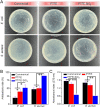SiO2 nanosphere coated tough catheter with superhydrophobic surface for improving the antibacteria and hemocompatibility
- PMID: 36704310
- PMCID: PMC9872198
- DOI: 10.3389/fbioe.2022.1067139
SiO2 nanosphere coated tough catheter with superhydrophobic surface for improving the antibacteria and hemocompatibility
Abstract
Catheter infection is the most common complication after vascular catheter placement, which seriously threatens the survival of critically ill patients. Although catheters with antibacterial drug coatings have been used, catheter infections have not been effectively resolved. In this research, a SiO2 nanosphere-coated PTFE catheter (PTFE-SiO2) with enhanced antibacterial and excellent mechanical properties was prepared via dopamine as a graft bridge. The microscopic morphology results show that the nanospheres are uniformly dispersed on the surface of the catheter. The physicochemical characterization confirmed that PTFE-SiO2 had reliable bending resistance properties, superhydrophobicity, and cytocompatibility and could inhibit thrombosis. Antibacterial results revealed that PTFE-SiO2 could hinder the reproduction of E. coli and S. aureus. This research demonstrates the hydroxyl-rich materials obtained by hydroboration oxidation have the advantages of better dispersion of functional coatings, indicating their potential for helpful modification of catheters.
Keywords: SiO2 nanosphere; antibacterial; blood compatibility; catheter; superhydrophobic.
Copyright © 2023 Zhang, Du, Zhu and Wang.
Conflict of interest statement
The authors declare that the research was conducted in the absence of any commercial or financial relationships that could be construed as a potential conflict of interest.
Figures








Similar articles
-
Study on PTFE superhydrophobic coating modified by IC@dMSNs and its enhanced antibacterial effect.J Adv Res. 2025 Apr;70:63-77. doi: 10.1016/j.jare.2024.04.026. Epub 2024 Apr 28. J Adv Res. 2025. PMID: 38688357 Free PMC article.
-
Porous Se@SiO2 nanosphere-coated catheter accelerates prostatic urethra wound healing by modulating macrophage polarization through reactive oxygen species-NF-κB pathway inhibition.Acta Biomater. 2019 Apr 1;88:392-405. doi: 10.1016/j.actbio.2019.02.006. Epub 2019 Feb 10. Acta Biomater. 2019. PMID: 30753941
-
Enhanced Antibacterial and Antiadhesive Activities of Silver-PTFE Nanocomposite Coating for Urinary Catheters.ACS Biomater Sci Eng. 2019 Jun 10;5(6):2804-2814. doi: 10.1021/acsbiomaterials.9b00071. Epub 2019 May 9. ACS Biomater Sci Eng. 2019. PMID: 33405585
-
One-step hydrophobization of tannic acid for antibacterial coating on catheters to prevent catheter-associated infections.Biomater Sci. 2019 Dec 1;7(12):5035-5043. doi: 10.1039/c9bm01223k. Epub 2019 Sep 19. Biomater Sci. 2019. PMID: 31535105
-
Surface modification strategies for hemodialysis catheters to prevent catheter-related infections: A review.J Biomed Mater Res B Appl Biomater. 2021 Mar;109(3):314-327. doi: 10.1002/jbm.b.34701. Epub 2020 Aug 31. J Biomed Mater Res B Appl Biomater. 2021. PMID: 32864803 Review.
Cited by
-
Medical Device-Associated Biofilm Infections and Multidrug-Resistant Pathogens.Pathogens. 2024 May 8;13(5):393. doi: 10.3390/pathogens13050393. Pathogens. 2024. PMID: 38787246 Free PMC article. Review.
-
Study on PTFE superhydrophobic coating modified by IC@dMSNs and its enhanced antibacterial effect.J Adv Res. 2025 Apr;70:63-77. doi: 10.1016/j.jare.2024.04.026. Epub 2024 Apr 28. J Adv Res. 2025. PMID: 38688357 Free PMC article.
References
-
- Alvarenga Dalila Junqueira, Matias Laira Maria Faria, Oliveira Lucas Martins, Leao Luiz Paulo Melchior de Oliveira, Hawkes Jamie Anthony, Raimundo Breno Vilas Boas, et al. (2020). Exploring how structural changes to new Licarin A derivatives effects their bioactive properties against rapid growing mycobacteria and biofilm formation. Microb. Pathog. 144, 104203. 10.1016/j.micpath.2020.104203 - DOI - PubMed
-
- Boinovich Ludmila B., Modin Evgeny B., Aleshkin Andrey V., Emelyanenko Kirill A., Zulkarneev Eldar R., Kiseleva Irina A., et al. (2018). Effective antibacterial nanotextured surfaces based on extreme wettability and bacteriophage seeding. ACS Appl. Nano Mater. 1 (3), 1348–1359. 10.1021/acsanm.8b00090 - DOI
-
- Brescia Fabrizio, Pittiruti Mauro, Scoppettuolo Giancarlo, Zanier Chiara, Nadalini Elisa, Bottos Paola, et al. (2021). Taurolidine lock in the treatment of colonization and infection of totally implanted venous access devices in cancer patients [J]. J. Vasc. Access 00 (0), 1–5. - PubMed
LinkOut - more resources
Full Text Sources
Molecular Biology Databases

